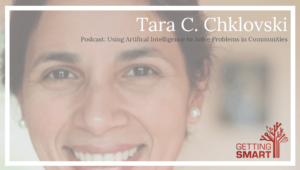Mind the Artificial Intelligence Gap
Key Points
-
Education data is nearly universally siloed and inaccessible, stored in applications and systems that don’t work together well, or at all.
-
Educators and schools don’t need more AI at this moment, they need better data and data that’s easier to use.

By: Eric Wang
I was fortunate to be one of the education technology leaders to present at the 2022 ASU+GSV Summit in San Diego in April.
It was an honor to host a panel on artificial intelligence in education and to rub elbows with so many smart, engaged and solution-oriented people. In the days since I’ve been back, I’ve been asked what I took away from the conference and what my headlines were, especially in the area of AI.
While it’s tough to boil down complex and fluid topics to pithy headlines, here’s one that I am taking away from GSV: educators and schools don’t need more AI at this moment, they need better data and data that’s easier to use.
Although this conclusion may be controversial in the hallowed and AI-crazed hallways of venture capital funds, I doubt it will be to most educators and administrators.
The problem with headlines is that they often lack context and nuance. I’m not saying that AI is not powerful or important or needed. To the contrary, we’ve only just started to see the benefits and rewards of what AI can do to improve teaching and learning. We are, in my view, just at the dawn of leveraging AI in education.
Nearly everywhere we look, the solutions and capabilities that AI can deliver today are already way ahead of what education data is capable of supporting. To put it another way, education entrepreneurs and engineers have designed and built some fast, cutting edge cars and trained some amazing drivers. But we don’t yet have the fuel–electricity, of course–to get them running.
It’s not that education data is bad, though some clearly is, which is a point I’ll explore in a future article. One of the primary problems is that education data is nearly universally siloed and inaccessible, stored in applications and systems that don’t work together well, or at all. To continue the car analogy, it’s like needing fast charging plug-ins and batteries when all we have is tanks of diesel gasoline and we never built a power grid. The power may be there but it’s in the wrong form and getting it where we need it just isn’t very easy.
Educators and schools don’t need more AI at this moment, they need better data and data that’s easier to use.
Eric Wang
The point is that even simple AI can already unearth insights and return valuable information based on the data that schools have and how it’s currently being used. We don’t need more AI or even better AI right now. Schools, and districts and teachers simply are not ready to use AI yet, even though it could be—will be—extremely beneficial.
In fact, I’d be inclined to tell technology purchasing leaders or school administrators that the next time someone comes in offering AI solutions, ask that individual how they’re going to do whatever they’re promising with the data that’s currently available and in place. Ask them how they plan to access, use and share the information your district has, as it exists today. Ask them how much they know about the state of the school’s data infrastructure, access and use.
If they can’t answer these questions, and they’re selling AI, then chances are that their solution might only add to existing data problems and thus not solve anything of significance.
Moreover, I’d also advise those of us working to provide AI education solutions to focus on our collective ability to use the data as we know it exists instead of how we imagine it to be. It’s on those of us in the AI field to figure out how to make information move powerfully and seamlessly between and among our various platforms and systems and services. It’s unwise and unfair to ask schools and education leaders to figure all that out on their own. It’s one thing to develop the powerful products of the future;it’s another thing to try to sell those products to people who may not be ready to use them.
It’s not nefarious. The people who I know are working tirelessly on squeezing actionable intelligence from classrooms are doing it for the right reasons–they want to contribute to improving the quality of teaching and learning. They want to put these amazing and powerful tools in the hands of educators. And they want to be able to do it today. I get it.
And it’s easy, even fun, to get swept up in the fever of the possible at a place like ASU+GSV. But that fever has to break somewhat when we realize that our schools, our teachers and our students are not dealing with what’s possible. They’re usually dealing with what’s manageable. In education AI, we’ve got to do better at minding that gap.
Eric Wang is the Head of Ai at Turnitin. He writes about artificial intelligence, equity, and machine learning. He holds a Ph.D. in electrical and computer engineering from Duke University.




Veena Reddy
Completely agree with your point that we have to more than just use AI for educational activities. The focus needs to be more on data than on building more AI.